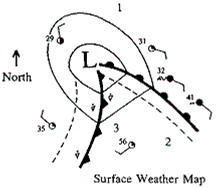During cellular respiration,
A. all the energy in a glucose molecule is lost to the environment as heat.
B. some of the energy in a glucose molecule is lost to the environment as heat, and some is converted to energy in ATP.
C. all the energy in a glucose molecule is converted to energy in ATP.
D. the biomass of the organism increases.
Answer: B
You might also like to view...
Cyclone

A. position 1 B. position 2 C. position 3 D. position 4
Atoms of a particular element that have a different number of neutrons in their nuclei are called
______. Fill in the blank(s) with the appropriate word(s).
The Columbia River has 119 dams and a fish problem. If you were the person in charge of determining what to do, what would you decide? Would you seek to free up the river in favor of the fish, or would you make a few accommodations for the fish and leave the dams in place? Explain.
What will be an ideal response?
Which sort of rocks are most susceptible to hydrolysis?
A) Metamorphic B) Unjointed C) Ones that do not react chemically with water D) Sedimentary E) Igneous